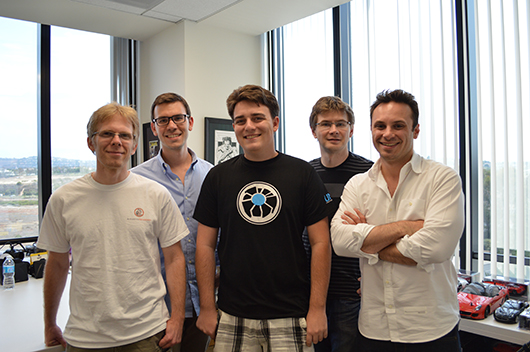Analogue hat mit dem Nt mini eine neue Spielekonsole vorgestellt, die sowohl NES- als auch Famicom-Spiele wiedergeben und mit Original-Zubehör genutzt werden kann. Anders als beim Vorgänger Nt kommen aber nicht mehr die Original-Chips des NES zum Einsatz. (Spielekonsole, Nintendo) 

Analogue hat mit dem Nt mini eine neue Spielekonsole vorgestellt, die sowohl NES- als auch Famicom-Spiele wiedergeben und mit Original-Zubehör genutzt werden kann. Anders als beim Vorgänger Nt kommen aber nicht mehr die Original-Chips des NES zum Einsatz. (
Spielekonsole,
Nintendo)


Samsung’s third smartphone to ship with the Tizen operating system is somewhat oddly called the Samsung Z2. It follows the Z1 and Z3. Go figure.
The new phone is launching in India, where it sells for INR 4,590 (about $68), and it’s the first Tizen smartphone to ship with support for 4ZG networks.
As you may have guessed from the price, the phone isn’t exactly a powerhouse. It features a 4 inch, WVGA display, a 1.5 GHz quad-core processor, 1GB of RAM, 8GB of storage, a 5MP rear camera, a VGA front camera, and a 1,500 mAh battery.
Continue reading Samsung launches the first Tizen-powered phone with 4G at Liliputing.


Samsung’s third smartphone to ship with the Tizen operating system is somewhat oddly called the Samsung Z2. It follows the Z1 and Z3. Go figure.
The new phone is launching in India, where it sells for INR 4,590 (about $68), and it’s the first Tizen smartphone to ship with support for 4ZG networks.
As you may have guessed from the price, the phone isn’t exactly a powerhouse. It features a 4 inch, WVGA display, a 1.5 GHz quad-core processor, 1GB of RAM, 8GB of storage, a 5MP rear camera, a VGA front camera, and a 1,500 mAh battery.
Continue reading Samsung launches the first Tizen-powered phone with 4G at Liliputing.

Die Regierungen von Deutschland und Frankreich wollen Kommunikationsdienste verpflichten, verschlüsselte Nachrichten der Nutzer zu entschlüsseln. Es bleibt unklar, wie das ohne Hintertüren gehen soll. (Störerhaftung, Instant Messenger) 

Die Regierungen von Deutschland und Frankreich wollen Kommunikationsdienste verpflichten, verschlüsselte Nachrichten der Nutzer zu entschlüsseln. Es bleibt unklar, wie das ohne Hintertüren gehen soll. (
Störerhaftung,
Instant Messenger)

Keine Ümläüte mehr in Öütlöök-IMÄP-Pässwörtern: Erst machte POP-3 bei Outlook 2016 Probleme, und Microsoft riet zum Umstieg auf IMAP. Jetzt nimmt IMAP nicht mehr alle Passwörter, und Microsoft rät dreierlei. (Outlook, Microsoft) 

Keine Ümläüte mehr in Öütlöök-IMÄP-Pässwörtern: Erst machte POP-3 bei Outlook 2016 Probleme, und Microsoft riet zum Umstieg auf IMAP. Jetzt nimmt IMAP nicht mehr alle Passwörter, und Microsoft rät dreierlei. (
Outlook,
Microsoft)

Demo car will be displayed at CES this year, production-grade systems ready in 2019.
A beautiful game that delivers a morosely charming blend of grief, rage, and fanaticism.
Zenimax has now added Oculus execs John Carmack, Brendan Iribe as defendants.

Microsoft’s HoloLens headset is basically a computer that you can wear on your head. It puts a semi-transparent display in front of your face, allowing you to interact with apps and games superimposed on your real-world environment. One of the key things that sets HoloLens apart from virtual reality headsets like the Oculus Rift is that you don’t need to plug the HoloLens into a computer, because it is a computer.
When Microsoft unveiled the HoloLens in January, the company said it has a CPU and graphics processor built in… as well as a custom chip called a Holographic Processing Unit that analyzes gesture, voice, and visual input, among other things.
Continue reading Microsoft reveals info about the custom chip powering HoloLens at Liliputing.


Microsoft’s HoloLens headset is basically a computer that you can wear on your head. It puts a semi-transparent display in front of your face, allowing you to interact with apps and games superimposed on your real-world environment. One of the key things that sets HoloLens apart from virtual reality headsets like the Oculus Rift is that you don’t need to plug the HoloLens into a computer, because it is a computer.
When Microsoft unveiled the HoloLens in January, the company said it has a CPU and graphics processor built in… as well as a custom chip called a Holographic Processing Unit that analyzes gesture, voice, and visual input, among other things.
Continue reading Microsoft reveals info about the custom chip powering HoloLens at Liliputing.

Engagement, downloads, and time spent in the app are fading fast.
Use of older military tech makes for a refreshingly first-person shooter sworder.
 Analogue hat mit dem Nt mini eine neue Spielekonsole vorgestellt, die sowohl NES- als auch Famicom-Spiele wiedergeben und mit Original-Zubehör genutzt werden kann. Anders als beim Vorgänger Nt kommen aber nicht mehr die Original-Chips des NES zum Einsatz. (Spielekonsole, Nintendo)
Analogue hat mit dem Nt mini eine neue Spielekonsole vorgestellt, die sowohl NES- als auch Famicom-Spiele wiedergeben und mit Original-Zubehör genutzt werden kann. Anders als beim Vorgänger Nt kommen aber nicht mehr die Original-Chips des NES zum Einsatz. (Spielekonsole, Nintendo)  Analogue hat mit dem Nt mini eine neue Spielekonsole vorgestellt, die sowohl NES- als auch Famicom-Spiele wiedergeben und mit Original-Zubehör genutzt werden kann. Anders als beim Vorgänger Nt kommen aber nicht mehr die Original-Chips des NES zum Einsatz. (Spielekonsole, Nintendo)
Analogue hat mit dem Nt mini eine neue Spielekonsole vorgestellt, die sowohl NES- als auch Famicom-Spiele wiedergeben und mit Original-Zubehör genutzt werden kann. Anders als beim Vorgänger Nt kommen aber nicht mehr die Original-Chips des NES zum Einsatz. (Spielekonsole, Nintendo) 
 Die Regierungen von Deutschland und Frankreich wollen Kommunikationsdienste verpflichten, verschlüsselte Nachrichten der Nutzer zu entschlüsseln. Es bleibt unklar, wie das ohne Hintertüren gehen soll. (
Die Regierungen von Deutschland und Frankreich wollen Kommunikationsdienste verpflichten, verschlüsselte Nachrichten der Nutzer zu entschlüsseln. Es bleibt unklar, wie das ohne Hintertüren gehen soll. ( Keine Ümläüte mehr in Öütlöök-IMÄP-Pässwörtern: Erst machte POP-3 bei Outlook 2016 Probleme, und Microsoft riet zum Umstieg auf IMAP. Jetzt nimmt IMAP nicht mehr alle Passwörter, und Microsoft rät dreierlei. (
Keine Ümläüte mehr in Öütlöök-IMÄP-Pässwörtern: Erst machte POP-3 bei Outlook 2016 Probleme, und Microsoft riet zum Umstieg auf IMAP. Jetzt nimmt IMAP nicht mehr alle Passwörter, und Microsoft rät dreierlei. (


